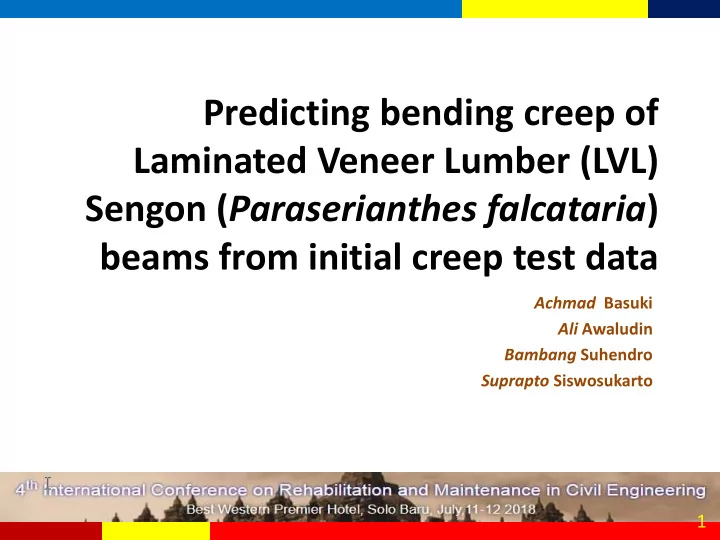

Predicting bending creep of Laminated Veneer Lumber (LVL) Sengon ( Paraserianthes falcataria ) beams from initial creep test data Achmad Basuki Ali Awaludin Bambang Suhendro Suprapto Siswosukarto 1
Creep is a deflection or deformation of structures due to permanent loading over time. Creep can cause serviceability problems due to excessive deformation or to a reduction in strength. The total deformation during the service life of a building must be limited. Understanding creep behaviour of material and structure will allow one to predict the behaviour of a building during its service life. Including buildings using wood and wood based (wood engineered) materials. 2 2
This research: Bending creep of laminated veneer lumber Sengon - Paraserianthes falcataria (LVL Sengon). LVL Sengon is manufactured by laminating veneers obtained from Sengon timber. Each veneer has a thickness from 2.5 to 3.2 mm and plies parallel to length using melamine urea formaldehyde (UF) adhesive under 0.6-0.7 MPa pressure. 3 3
Bending creep experiment Creep experiments has been done on LVL Sengon beams for 3 (three) months in a temperature- and humidity- controlled room. The dimensions of LVL Sengon beam is 40 mm in thickness, 80 mm in width, and 2000 mm in (clear) length. Beam edges are simply supported and loaded at mid-span by loading levels of 30%, 40%, and 50% of the ultimate load, which correspond to 215 N, 285 N and 355 N, respectively. There are three unwrapped beams and one wrapped (with plastic sheet) beam for each loading level. 4 4
Creep model of LVL Sengon LVL Sengon is assumed to be a viscoelastic material . A viscoelastic material exhibits elasticity under rapid loading, then its strain increases slowly and continuously. Viscoelasticity combines elasticity and viscosity (viscous flow) . 5 5
Modification of Burger creep model Result 6 6
By using the Toolbox Solver program available in Microsoft Excel , the parameters in Eq. (1) and (2) that represent the Burger and Modified Burger creep model are deter- mined, and plotted to bending creep data. 7 7
8 8
Curve fitting of bending creep data – load level 30% 9 9
Curve fitting of bending creep data – load level 40% 10 10
Curve fitting of bending creep data – load level 50%. 11 11
Prediction 3 months of bending creep from 1-month creep data (Beam 1) 12 12
Prediction 3 months of bending creep from 1-month creep data (Beam 2) 13 13
Prediction 3 months of bending creep from 1-month creep data (Beam 3) 14 14
Prediction 3 months of bending creep from 1-month creep data (Wrapped Beam) 15 15
Conclusion: 1. The Modified Burger model can be used to predict bending creep of LVL Sengon beam. 2. A longer bending creep testing is required to obtain a more satisfactory result on bending creep of LVL Sengon. 16 16
Thank you for your attention 17 17
Recommend
More recommend